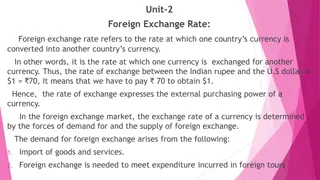Understanding Commercial Bills Market and Types of Bills of Exchange
The commercial bills market involves financing through discounting commercial bills, which are bills of exchange from genuine trade transactions. This article explains the types of bills of exchange, such as demand bills, usance bills, and more, along with the advantages and drawbacks of commercial bills.
Download Presentation

Please find below an Image/Link to download the presentation.
The content on the website is provided AS IS for your information and personal use only. It may not be sold, licensed, or shared on other websites without obtaining consent from the author. Download presentation by click this link. If you encounter any issues during the download, it is possible that the publisher has removed the file from their server.
E N D
Presentation Transcript
COMMERCIAL BILLS MARKET OR DISCOUNT MARKET
COMMERCIAL BILLS MARKET OR DISCOUNT MARKET The market where finance is provided by discounting of commercial bills is called as commercial bills market. Commercial bills refer to the bills of exchange arising out of genuine trade transactions. Section 5 of the Negotiable Instruments Act defines a bill of exchange as an instrument in writing containing an unconditional order, signed by the maker, directing a certain person to pay a certain sum of money only to, or to the order of a certain person or to the bearer of the instrument . Finance against bills of exchange is provided by many commercial banks by discounting the bills before their maturity. The process of taking over of a bill of exchange for a lesser value than the face value is called as discounting of bills. In India this market is not very well developed and hence, it does not have a secondary market.
TYPES OF BILLS OF EXCHANGE 1. Demand Bills These are the bills payable immediately as soon as they are presented. The time of payment is not specified in these bills. These are also called as Sight bills as they are payable at sight and not at the expiry of a specified period. 2. Usance Bills These are the bills payable at the expiry of a specified period. The time of payment is specified in these bills. These are also called as Time bills as they are payable after the expiry of a specified period like three months, four months, etc., 3. Documentary Bills These are the bills that accompany the documents of title to goods like Railway receipt, Lorry receipt, Bill of lading, etc., 4. Clean Bills These are the bills that do not accompany the documents of title to goods. 5. Inland Bills These are the bills that are drawn upon a person residing in India and are payable in India.
TYPES OF BILLS OF EXCHANGE 6. Foreign Bills These are the bills that are originated or drawn outside India upon a person either outside India or a person residing in India and are payable either in India or outside India. 7. Export Bills These are the bills that are drawn by Indian exporters on importers of other country. 8. Import Bills These are the bills that are drawn by Exporters of other country on the Indian importers. 9. Indigenous Bills These are the bills that are drawn by indigenous bankers according to native custom or usage of trade. The popular name of these bills is Hundi . The hundis are known by different names like Shah Jog, Nam Jog, Jokhani, Termain Jog, Darshani Jog, Dhani Jog, etc. 10. Accommodation Bills These are the bills that are drawn for the purpose of mutual financial needs of the parties and are not supported by a genuine trade transaction. They are also called as Kite bills & Wind bills.
ADVANTAGES OF COMMERCIAL BILLS 1. Provision of liquidity 2. Certainty of payment 3. Ideal investment 4. Simple legal remedy 5. High and quick yield 6. Easy central bank control
DRAWBACKS OF COMMERCIAL BILLS 1. Absence of bill culture 2. Absence of rediscounting facility 3. Stamp duty and inadequate availability of stamp papers 4. Absence of secondary market 5. Difficulty in ascertaining genuine trade bills 6. Limited foreign trade 7. Absence of acceptance services 8. No encouragement by banks for rediscounting.























